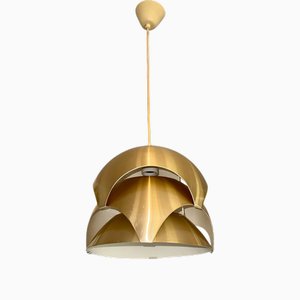
Born in 1931 in Oslo, Sven Ivar Dysthe is a Norwegian industrial and furniture designer, who is particularly renowned for his postwar contributions to the Norwegian strain of Scandinavian modern design.
Rare among Norwegian designers of his era, Dysthe studied outside his homeland at London’s Royal College of Arts, the powerhouse institution that has more recently incubated contemporary designers like Max Lamb, Simon Hasan, James Irvine, , and Studio Glithero’s Sarah van Gameren. Graduating in 1954 with a degree in industrial design—and the rare distinction of a First Class graduate—Dysthe moved around Scandinavia for his initial employment: first, in Copenhagen, at Peter Hvidt and Orla Mølgaard Nielsen’s design firm; then back in Oslo, where in 1956, on assignment for furniture manufacturer Hiorth & Østlyngen, Dysthe produced his beech, teak, and woven seagrass Model 316 Dining Chair, a robust and honest exemplar of where Scandinavian design was moving at the time.
Around the time of tenure with Hiorth & Østlyngen, Dsythe met his future wife, Trinelise Hauan, who had recently graduated from Copenhagen’s School of Interior Design, where she studied under Finn Juhl. Together they established a design studio in 1958 and delved quickly into freelance work, focusing chiefly on industry-adapted models. Among their first and ultimately most iconic designs was the steel and rosewood 1001 Armchair (1959) for Dokka Møbler, which eventually spawned five further iterations of the series. Lasting classics of Norwegian design, emblematic of the best of midcentury modernism, these pieces are further notable for having been heavily featured on the American TV series Mad Men.
In the 1960s—much like other postwar designers including Charles & Ray Eames—Dysthe began experimenting with plastic moulding techniques and new materials like polyurethrane. His experimentation culminated in his first shell chair, the hemispherical Globus for Møre Lenestolfabrikk (1963). Soon after, Dysthe designed what would be his second tour-de-force, the Laminette Chair (1967), which sold more than 800,000 copies and garnered three prestigious awards: the Gold Medal at the 1968 Ljubljana Biennale, a Japanese G-Mark for good design, and the Norwegian Classic Award for Design Excellence.
Sven Ivar Dysthe received the Jacob award in 1989. In 2010, he was appointed a knight of the 1st grade of the Order of the Royal Norwegian St. Olavs. His works have been collected by many venerable institutions, such as the in London, the National Museum in Stockholm, and the National Museum in Oslo.

